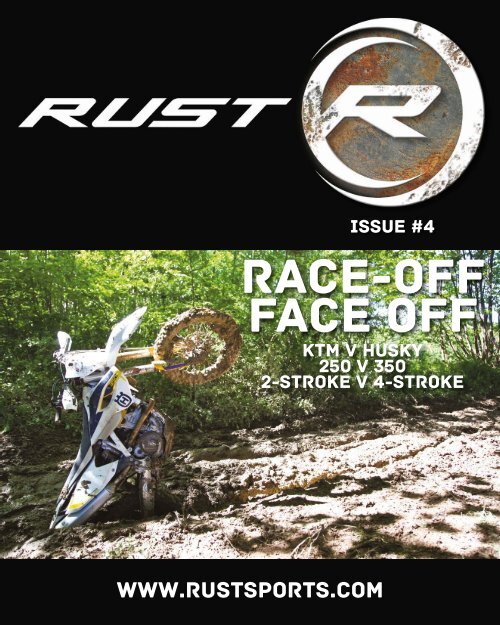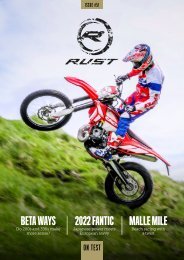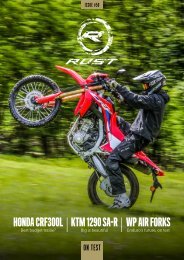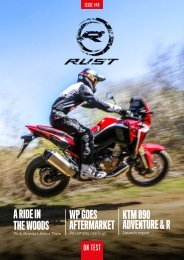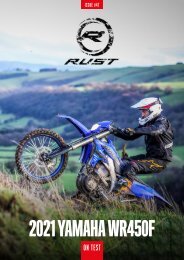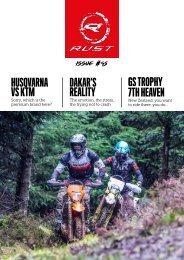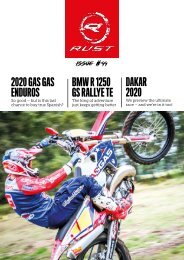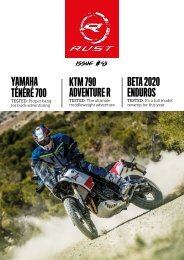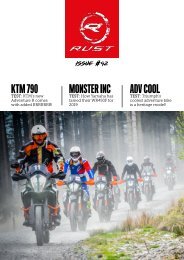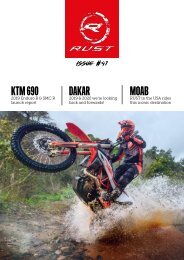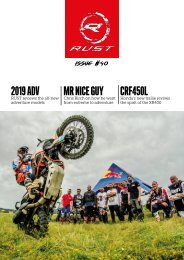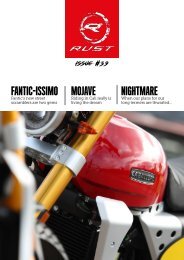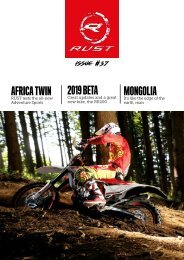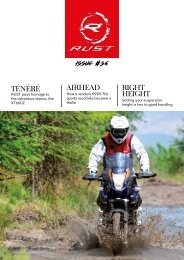RUST magazine: Rust#4
RUST magazine: Two-stroke or four-stroke…? It’s the age-old debate that’s perplexed dirt riders the world over. So, armed with a KTM 250EXC and a Husky TE350, RUST decided to try and settle the argument once and for all. Find out what happened when they went head-to-head in a two-day French enduro. And if you’re looking for a compact Adventure Sport bike but don’t want to break the bank then this lightly modded Honda CB500X may be just the ticket.
RUST magazine: Two-stroke or four-stroke…? It’s the age-old debate that’s perplexed dirt riders the world over. So, armed with a KTM 250EXC and a Husky TE350, RUST decided to try and settle the argument once and for all. Find out what happened when they went head-to-head in a two-day French enduro. And if you’re looking for a compact Adventure Sport bike but don’t want to break the bank then this lightly modded Honda CB500X may be just the ticket.
You also want an ePaper? Increase the reach of your titles
YUMPU automatically turns print PDFs into web optimized ePapers that Google loves.
issue #4<br />
race-off<br />
face off<br />
KTM V HUSKY<br />
250 V 350<br />
2-STROKE V 4-STROKE<br />
www.rustsports.com
Ed itorial<br />
making<br />
a splash<br />
By SI MELBER,<br />
photo: Josh Snowden<br />
Hi there<br />
WOW… You guys are just amazing. Over the Christmas period (from 18 Dec<br />
until 4 January) more than 27,000 of you requested a download for our third<br />
full issue: <strong>RUST</strong> #3. And in December alone we had 52,601 download requests<br />
covering all six of our issues (and special issues) that we’ve published so far.<br />
That’s nearly 1700 download requests per day… And when you take into<br />
account that we only launched <strong>RUST</strong> in November last year, that is an<br />
incredible achievement from a standing start.<br />
Better still we had download requests from more than 45 countries worldwide<br />
from as far afield as the Philippines, Iceland, Tanzania, Papua New Guinea,<br />
Lesotho, Hawaii and the Falkland Islands; with the UK, USA, Australia, South<br />
Africa, Holland, Poland, Germany, Austria, Italy, Spain, Portugal, France, New<br />
Zealand, Canada and Chile being the highest represented.
So thank you guys and girls… Thank you for believing in us, and for<br />
recommending us to your dirt biking buddies and biking forums around the<br />
globe. And thanks for sharing in the <strong>RUST</strong> philosophy of simply having fun<br />
on dirt bikes. We have got an awesome year of testing, racing, videoing and<br />
fooling around on dirt-bikes planned, and we aim to bring you much more of<br />
the same. So help yourself to <strong>RUST</strong> #4, share it with as many people as you<br />
like, tell all your friends about us and remember that at any time of day or night,<br />
chances are there’s someone like you out there reading a copy of <strong>RUST</strong>. You<br />
guys are awesome… Si Melber<br />
We want to hear from you. Contact editorial@rustsports.com with your feedback.
Jon Bentman<br />
a sense of<br />
adventure<br />
By jon bentman,<br />
photos: j bentman & various<br />
THE FIGURES DON’T LIE. The Adventure Sport category is booming...<br />
Here in the UK sales are up by nearly 30% in a year. More than that, it’s<br />
proving to be the savior of the motorcycle industry in many developed<br />
countries. Oh sure we still buy plenty of sportsbikes, (N Europe & S Africa),<br />
cruisers (N America & Sweden), naked bikes (S Europe), small bikes<br />
(E Europe and the far East) and dirtbikes (pretty much everywhere), but<br />
Adventure Sport is what’s making the marketeers take a step back from<br />
their high precipices. And here at <strong>RUST</strong> we understand the simple pleasure<br />
of travelling to far-flung places on a dual-sport motorcycle.<br />
My own background in Adventure Sport starts like most peoples’ in that<br />
I progressed to it from a different discipline altogether. A mix of road riding,<br />
road racing, trials, enduro and road-testing in my case. And like many<br />
people I guess, I took a while to really understand just what adventure bikes<br />
are all about.<br />
One of the first adventure bikes I <strong>magazine</strong>-tested was a BMW R1150GS<br />
Adventure around 15 years ago. I was living in New Zealand at the time and<br />
given the fact that roughly two-thirds of NZ’s roads are gravel, it was just the<br />
perfect machine for eating up the mixed road mileage. But on that test I also<br />
took the GS to Pukekohe road race circuit, and despite the Conti TKC knobblies<br />
and pouring rain I batted it around the track for a whole afternoon.
Jon Bentman<br />
Obviously it wasn’t the fastest machine there that<br />
day, but it was the biggest and probably the most exciting.<br />
And flat-out down the mile-long straight it was<br />
kicking up one hell of a rooster tail of spray. Only afterwards<br />
did I notice the speed rating on the tyre walls -<br />
160km/h.<br />
The point was that I suddenly discovered that here<br />
was a bike that didn’t need to slow down to a crawl<br />
when the tarmac turned into gravel. Matter of fact<br />
that simply made it even more fun.<br />
Back in the UK in 2004, and while mixing enduro<br />
testing for MotoX <strong>magazine</strong> and road testing for<br />
Motorcycle Sport & Leisure, I was loaned an R1200GS<br />
and took it to the Isle of Man TT. It was a little slow up<br />
the mountain compared with the litre sportsbikes, but<br />
big enough and bad enough to hang with the fast<br />
crowd around the rest of the lap. And if you fancied<br />
it you could cut across the course on the Manx trails<br />
and pop out at another great spectator spot. Fireblade<br />
owners could only stare in disbelief as you turned off<br />
the tarmac onto one of the island’s green roads. It was<br />
an incredible bike.<br />
Later, around 2008, a KTM 950 Super Enduro<br />
landed in my lap, and a 500-mile round trip to Wales<br />
to compete in the Cambrian Rally was handled with<br />
ease. The SE was awesome everywhere, from<br />
motorway to single-track - oh, except on damp grass.<br />
Later on that year, I rode a solo mission on a Honda<br />
XR650 over the pistes of the Moroccan High Atlas.<br />
It was something of an adventure epiphany… sure<br />
‘<br />
The<br />
R1150GS w<br />
machine on the ra<br />
its Conti knobblies<br />
over 100mph it w<br />
of the mos<br />
the bike is important, but ac<br />
bike, as much as where it c<br />
Then in 2010 I was emplo<br />
press officer on the Interna<br />
Africa. We rode our F800G<br />
on gravel, in deep sand, thr<br />
(elephants hate bikes) and<br />
bloody tough but it gave me<br />
just what you can do on an<br />
how much fun they are.<br />
And now three internation<br />
(South America and Canad<br />
fourth in Thailand just week<br />
appeal of a bike that can ta<br />
can only dream about. Tha
asn’t the fastest<br />
cetrack, but with<br />
only rated to just<br />
as certainly one<br />
t exciting...<br />
’<br />
tually it’s not about the<br />
an take you.<br />
yed by BMW as a riding<br />
tional GS Trophy in South<br />
Ss for seven days on grass,<br />
ough wildlife reserves<br />
on tarmac. The riding was<br />
a new appreciation of<br />
adventure bike - and just<br />
al BMW GS Trophies later<br />
a followed) - and with a<br />
s away - I totally get the<br />
ke you to places your mind<br />
t’s my way of explaining<br />
the huge appeal of the Adventure Sport market. It’s<br />
a cliché I know, but these are bikes that don’t have to<br />
stop, even when the road runs out.<br />
That’s why here at <strong>RUST</strong> we’re looking at adventure<br />
bikes from the perspective of our own lifetime riding<br />
motorcycles. And because we’re a dirtbike-led<br />
publication, we’re assessing these bikes on their<br />
dynamic capability off-road before we even think to<br />
check out the capacity of the OEM pannier kit, or the<br />
fuel range. Yep, probably like you, we’ve ridden<br />
GSX-Rs and CBRs then WRs and EXCs, heck we’re<br />
old enough to throw in KDXs, PEs and ITs - TransAlps<br />
and Ténérés too - but given our enduro background<br />
we can’t deny we approach adventure bikes from that<br />
start point: can it deal with the dirt?<br />
And if all that sounds like we’ll be ragging these<br />
bikes down the trails like some demented wannabe<br />
desert racer, fear not. Age and reason have finally<br />
imparted a degree of commonsense (not to mention<br />
self-preservation) in us all. Adventure bikes are in<br />
effect viewing platforms from which to see and experience<br />
the rest of the world via the trail less travelled.<br />
So, in the coming issues of <strong>RUST</strong> you’ll continue<br />
to find plenty of adventure, whether it’s bike tests<br />
or travel stories. Yeah, we love ‘the nature’ (as the<br />
Europeans like to call it), but to access that nature<br />
confidently we need the right bikes. Adventure Sport<br />
bikes give us that ability and my guess is that many<br />
of <strong>RUST</strong>’s readers are also discovering that for<br />
themselves…
Back Issues<br />
www.rustsports.com<br />
www.youtube.com/watch?v=54lfOS3nMtE<br />
www.youtube.com/watch?v=mVYqp3biTnc<br />
www.youtube.com/watch?v=6XEkJabHLi4<br />
www.youtube.com/watch?v=QrOoVPEKi_E<br />
www.youtube.com/watch?v=gvyUxbymuMU<br />
www.youtube.com/watch?v=HQBn2qbfopY<br />
www.youtube.com/watch?v=HX4-14sIoHE<br />
www.youtube.com/watch?v=_L8ePyI2E4M<br />
www.youtube.com/watch?v=yriJw_FU910<br />
www.youtube.com/watch?v=8l54XQOYoPo www.youtube.com/watch?v=ooPAurYxQzY www.youtube.com/watch?v=9oHMTpB0RNw<br />
www.youtube.com/watch?v=mLpIT6Z-ACQ<br />
www.youtube.com/watch?v=ntK07I63tuA<br />
www.youtube.com/watch?v=x_co4hGeECA<br />
Visit www.rustsports.com for the latest video content,<br />
social media feeds and issues...<br />
To view any of these videos just click on the link below the<br />
thumbnail to go direct to the Rust Sports youtube channel...
issue #1 africa twin special<br />
issue #2 husqvarna 701 special yamaha wr450F special<br />
issue #3 issue #4 issue #5 issue #6 issue #7<br />
gs trophy special<br />
Issue #8<br />
issue #8 issue #9<br />
Subscribe for free at www.rustsports.com<br />
and we’ll e-mail you when a new issue comes out...<br />
All material appearing in <strong>RUST</strong> is copyright to Rust Sports Ltd and may not be reproduced<br />
in part or full (including electronically) without the express permission of the publishers.
Enduro
2015 KTM 250EXC v<br />
2015 Husqvarna TE350...<br />
KTM v Husky<br />
250cc v 350cc<br />
2-stroke v 4-stroke
Enduro
IT’S AN UNDISPUTED truth that the rate of sales of<br />
four-stroke dirt bikes has been slowing down globally...<br />
against a backdrop of sharply rising sales overall. The<br />
humble two-stroke - once derided by the marketeers<br />
for its unsophisticated and polluting powerplant - has<br />
survived the onslaught of its late-coming clean-burn<br />
rival, and continues to buck the trend; improving its<br />
sales year on year. And yet if you look at all the top<br />
racers they’re winning on four-strokes. so how come<br />
there’s a disconnect here between the old adage of<br />
‘Race it on Sunday, sell it on Monday’, and the kind<br />
of machinery that customers are actually buying?<br />
Well we should never forget that top racers are paid<br />
to ride whatever type of bike their paymasters want<br />
them to pilot. And whilst no racer worth his timecard<br />
would sacrifice their chance of winning by choosing<br />
an uncompetitive machine, the fact remains that<br />
in the hands of a decent rider the four-strokes are<br />
not just competitive… they are arguably better.<br />
This is all down to the differences in power delivery<br />
and the differences in skill between a top rider and<br />
guys like you and me. Four-strokes with their greater<br />
compression and stratospheric rev-ceilings can be<br />
made to produce more power and in the hands of<br />
a decent rider able to exploit it, that’s an advantage.<br />
Now if you talk to the average Sunday club racer<br />
on board a 250F for example, they’ll tell you that the<br />
four-stroke’s more mellow power delivery suits their<br />
riding style better, and you can’t really argue with that.<br />
Two-strokes can be peaky, hard to control things at<br />
times. And yet so much of how we perceive a bike’s<br />
merits is based on the type of riding we do and -<br />
frankly - our own abilities.
Enduro
DON’T CARE what anyone else says… the 450cc<br />
thumper as a competitive animal in club enduro racing<br />
in Europe (at least) has had its day. Sure, they sell a<br />
trillion of the things to knock over trees in Australia, and<br />
yes…. if I was going bush with hundreds of kays between<br />
gas stations that’s probably what I’d choose to ride. But from<br />
the point of view of racing all day in the confines of a tight<br />
and/or technical European enduro, why make life difficult?<br />
Truth is… you’d have to be mad (or masochistic) to pick a 450<br />
over any other class of bike. The 350 thumper, is another matter.<br />
Husqvarna’s TE350 has a powerplant that’s small and compact,<br />
with a light(ish) crank effect, a great mix of power and torque,<br />
seamless four-stroke rev-ability, a top class chassis and suspension<br />
that’s bang on the money. It seems to offer the clubman rider<br />
precisely the blend of hard-charging four-stroke performance they<br />
can exploit, with the softer edge of the thumper’s usability they need.
Enduro<br />
In other words it’s got pretty much most of the 250F’s<br />
easy-going delivery, with pretty much most of the<br />
450F’s performance. Not all mind you…. but most.<br />
Up against that is the benchmark bike of the past<br />
decade. KTM’s 250EXC. Rip-snortingly fast at times,<br />
yet also immensely torquey, light as a feather and good<br />
at everything. Hard to tame when the power-valve is<br />
open, yet sweet and fluffy when you’re working the<br />
low-end torque; it needs no further introduction here.<br />
How would the best thumper stack up against the<br />
best two-stroke? On paper they are a pretty good<br />
match. Obviously they both come out of the same<br />
Mattighofen factory so the chassis dynamics, suspension<br />
and build quality - whilst different - are on a par<br />
with each other. The power they produce is similar<br />
(though delivered in different ways), and of course<br />
they are in competition with each other for the same<br />
customers. But the overall dynamics of the two<br />
machines are quite different and that’s what we are<br />
testing here. Would the four-stroke’s more relaxed<br />
nature work better over the course of a gruelling two<br />
day enduro, and allow it to triumph over the more feisty<br />
stroker? Or would the stroker’s light front end and lack<br />
of ‘crank-effect’ prove superior? we wanted to find out.<br />
The event we chose to test these bikes at was the<br />
Grappe de Cyrano - one of France’s very best enduro<br />
‘Classics’ - a two-day, 450km high-speed romp through<br />
the Dordogne countryside, with 600 other riders for<br />
company. We were lucky enough to be guests of the<br />
club and that allowed us the opportunity to ride the
ace and stop for pics. Not that there<br />
was much time for stopping, truth be told.<br />
The Dordogne is well known as one of the<br />
most scenic parts of rural France. Its rolling<br />
countryside, deep gorges, heavily undercut<br />
Chalk escarpments and gorgeous<br />
wooded valleys make it an<br />
amazing place to ride a dirt bike.<br />
Throw in glorious weather, a<br />
super-friendly and well-organised<br />
enduro club, excellent<br />
special tests and hundreds of<br />
miles of amazing single-track<br />
through deciduous woodland<br />
and you have the recipe for<br />
enduro heaven. Bring it on<br />
Pierre….<br />
Husqvarna TE350<br />
If I was going to buy a bikefor-all-seasons<br />
this is the<br />
one I’d choose. Husqvarna’s<br />
re-emergence from the<br />
gloom of the ill-fated
Enduro<br />
Italy/BMW years has been pretty meteoric. In fairness,<br />
kinder economic conditions have played their part too.<br />
And it’s hard to avoid mentioning the fact that the<br />
Husky is fundamentally a KTM in all but name. Nevertheless<br />
such differences as there are - suspension,<br />
tank, subframe and styling - are to my mind at least,<br />
sufficient reason alone to warrant choosing the ‘Varna<br />
brand over its more orange-y stablemate.<br />
I actually love KTM’s styling, but am I alone in thinking<br />
that it looks even sexier in Husky white? Throw in<br />
the historic Husky name and you have a pretty convinc-
ing argument for the (non-orange) bike.<br />
From the second that you swing your boot across<br />
the saddle of the TE, settle yourself into the surprisingly<br />
comfortable seat (it remained so even after a<br />
250km day), and then thumbed the TE’s starter and<br />
blipped the injection-fed motor, you know this bike<br />
is going to be good. Really... goddamn... good.<br />
Day one began after a hearty breakfast of basically<br />
jam eaten from a pot, with me familiarising myself<br />
with the TE, and truth be told this process didn’t take<br />
long. After the very first track, I had the Husky up<br />
into top gear and thrumming along like a good-’un.<br />
I have to say the 350 motor on this sort of open<br />
going is really sublime. It has a lovely revvy feel<br />
about it that seems to maximise the engine’s<br />
usefulness and character. In other words you’re<br />
working the motor right in the sweet zone between<br />
maximum torque and maximum power rather than<br />
thrashing the rings off it or lugging it along, too<br />
scared to open it up. Throttle response is moreor-less<br />
instantaneous, though not so fierce that<br />
it becomes a problem like it can be with a 450.<br />
Here in the Dordogne the tracks are relatively<br />
fast and free-flowing - most of the time was spent<br />
in fourth and fifth gear picking a line between trees,<br />
looking ahead to what’s coming up and trying to<br />
adjust to the dappled light that filters down through<br />
the canopy above you. Here’s where the 350 Husky<br />
can really work its subtle magic. Because the lightweight<br />
crank builds revs fast, the 350 responds instantly<br />
to the throttle and the second you feel it’s<br />
safe to crack the throttle you get that puppy buried...<br />
all of which translates into decent trail speeds.
Enduro
You do have to stir the gearbox a good deal more than you<br />
would on a 450 but that’s no real hardship and ensures you<br />
have the right gear selected for the conditions. No matter what<br />
the revs or gear though, there’s always sufficient power to lift the<br />
front wheel up and over small hazards - doesn’t matter how late<br />
you spot them, and the real beauty of the 350 is that whilst it feels<br />
plenty fast enough, it rarely feels dangerously so. But just as you<br />
find with the 250F (with which it shares an engine) it’s a motor you<br />
definitely have to work at, in order to get the best out of it. And if<br />
you’re prepared to work both the throttle and the gearbox then you<br />
can make surprisingly swift progress over all kinds of terrain. Espe-
Enduro<br />
cially at the top end where the 350 just loves to rev on<br />
and on, and delivers decent power to the ground. In<br />
fact at the top end the motor’s lack of torque (obviously)<br />
and sensible amounts of horsepower make it surprisingly<br />
controllable.<br />
But whilst the top end is sufficiently thrilling and the<br />
midrange feels wonderfully alive, the 350F’s bottom<br />
end is surprisingly poor. Sure there’s a bit to keep you<br />
happy, but ultimately the motor needs to be spinning<br />
towards its midrange before it really comes alive. More<br />
250F than 450F then…<br />
Just occasionally this catches you out. I’ve mentioned<br />
before that in slow or tricky going the 350 can feel a bit<br />
of a handful. The engine isn’t particularly ‘cammy’ but<br />
sometimes it feels that way - thanks in part to the bike’s<br />
gearing. There’s quite a large gap between ratios lower<br />
down and occasionally you can get caught in no-man’s<br />
land (wanting a ratio in between first and second gear)<br />
simply because there’s insufficient torque at the bottom<br />
to pull the next higher gear; but when you drop down<br />
a cog, you can suddenly find yourself fighting the<br />
spiralling revs.<br />
I can remember discovering this at the launch of the<br />
350 in Sweden at a particularly bumpy and technically<br />
demanding test track, and in the Dordogne it happened<br />
again - albeit briefly - on both days. Where you find<br />
yourself in really tight going, though not so tight that<br />
you are ‘trials riding’, but where you desperately want<br />
to shift out of first gear to avoid the bike lurching on<br />
an open throttle. But as soon as you change up, you
Enduro
ealise that it simply won’t lug like you need it to.<br />
Personally I think first gear as specified is probably<br />
just a bit too low a ratio, and could do with being raised<br />
up a tooth to bring it closer to second. It’s not a serious<br />
complaint, more of an observation really, but one I’ve<br />
noted on more than one occasion now.<br />
For the most part though the 350’s motor is an<br />
amazing ally; thundering along, always ready to give<br />
power when you need it. And boy is this thing rapid<br />
when the track opens up. But it’s not so much the<br />
overall speed, as the way it gets there that impresses.<br />
Unlike a 250F which can feel slightly lame at times,<br />
or a 450F which can be intimidating to ride, the 350<br />
has the exact measure of what a clubman rider needs.<br />
And what’s more it produces it in an incredibly linear<br />
way so that you can exploit it all. That makes it fun to<br />
ride on a long course like this.<br />
Sure if you’re just thrashing round and round a<br />
farmer’s field a 250F would be probably all you needed,<br />
but this thing really lets you tackle the open countryside;<br />
it takes distances at race pace without feeling<br />
breathless or strained, it handles the road sections<br />
with aplomb (and smoothly) and yet it feels small and<br />
light enough to ride all day long.<br />
And the stock suspension feels so well specified and<br />
dialled in that there wasn’t anything I would change<br />
about it. You could argue that the factory settings are<br />
a touch on the soft side for an 85+kg rider like me,<br />
but it didn’t seem to make any difference to the magic<br />
carpet ride. The beginning part of the stroke was super<br />
supple, but that made the bike all-day comfortable to<br />
ride, and it firmed up nicely in the mid-stroke. Despite<br />
hitting things at trail speeds of up to 65mph (and more)<br />
it never bottomed out or wallowed at all. That said if
Enduro<br />
you were a particularly hard rider, a switch to the optional<br />
heavier weight springs might prove beneficial.<br />
So how about the rest of the riding experience? Well<br />
for me there was nothing I would really change about<br />
the Husky’s riding position, aside from - perhaps -<br />
ordering a set of extra-wide pegs for the added comfort<br />
and control they provide. At 5’11” I reckon I’m about the<br />
ideal height for the TE350 - any shorter and I’d be on<br />
tip-toes at a standstill, and any taller and I be stooping<br />
down like Rust Sports’ other test rider JK as he walks<br />
down the street like the cartoon character Grape Ape,<br />
collecting the dog-ends he likes to smoke.<br />
The great thing about the TE350 is that it’s an<br />
amazingly balanced machine with a very natural riding<br />
position that puts you just forward of the centre of the<br />
bike. This keeps both ends of the suspension working<br />
evenly and allows for good control in terms of handling.<br />
The bike is surprisingly narrow about its midriff (quite<br />
a lot narrower than the two-stroke), and this provides<br />
a superb feeling of control as you flick-flack from side<br />
to side between trees.<br />
However, if there was one thing I wasn’t so keen on it<br />
was the four-stroke crank effect and the way it flattens<br />
off the bike’s trajectory across the ground - meaning it<br />
always finds the lowest part of the course. This may<br />
seem a strange comment, given that the 350 is quite<br />
obviously a four-stroke, but it’s one of the inherent<br />
problems with thumpers off-road - that they tend to<br />
gravitate towards the outside of a corner or the bottom<br />
of a rut. Blast into a turn heading for the inside line and
Enduro<br />
I guarantee you’ll end up on the outside of the corner.<br />
It’s pretty frustrating at times. Same goes for a series<br />
of ruts where it’s almost impossible to float the front<br />
end delicately over them, what happens is on a trailing<br />
(or steady) throttle the bike nosedives in… and it’s only<br />
when you deliberately wheelie it that you can avoid the<br />
front end ploughing through the rut.<br />
This is a side-effect of crankshaft inertia and it’s<br />
completely unavoidable on a thumper. Obviously it’s<br />
less pronounced on a 250F and more pronounced<br />
on a bigger bike with a bigger crank, but it’s scarcely<br />
evident on the lighter-cranked two-stroke.
For the most part the 350 blasted through most of the<br />
ruts without drama but on day two approaching a bikeswallowing<br />
hole (which was far too deep to be wheelied<br />
through), it found the bottom point and wedged itself<br />
solid. And I do mean solid. It took us 15 minutes and<br />
three people to drag the bike clear. The KTM rider saw<br />
the hole and took avoiding action, the two-stroke’s light<br />
front end allowing it to switch lines easily and - lacking<br />
the dramatic and influential crankshaft effect - it simply<br />
re-routed when called upon to do so.<br />
On a thumper this doesn’t always happen. I also<br />
saw the hole in good time on the Husky, and tried to<br />
take avoiding action… But despite lifting the front end<br />
to change line, the Husky - driven on by significantly<br />
more gyroscopic effect from all that crankshaft inertia<br />
ploughed straight on into the rut and buried itself.<br />
That’s the difference with a four-stroke. The effort<br />
required to initiate a turn is greater. You may say pilot<br />
error. I say….. true enough, but when the same thing<br />
happens to you, you will remember these words...<br />
And then there’s another area where the four-stroke<br />
clearly loses out to the two-stroke, and that’s on<br />
descents. I’ve lost count of the number of people<br />
who’ve told me they prefer to ride a thumper because<br />
the engine braking helps them to slow down when<br />
they’re going downhill.<br />
Really……? Those guys need to reacquaint themselves<br />
with the unbelievable braking abilities of a twostroke.<br />
Because despite weighing similar amounts (and<br />
despite a lack of engine braking), the two-stroke always<br />
took less time and distance to slow down and - perhaps<br />
more importantly - felt much easier doing it. And on the<br />
steep, rocky descents it was the thumper which always
Enduro<br />
found the lowest line on the course, which is rarely the<br />
best one. Sure a good rider can ride around these traits<br />
and I’m not saying it’s a major deal, but it was noticeable<br />
that when I switched to the two-stroke my choice<br />
of line on downhills quadrupled. So now seems an appropriate<br />
time to tell you about the two-stroke.<br />
KTM 250EXC<br />
After a long and pleasant day spent charging-hard<br />
aboard the Husky, during which I’d had no major<br />
problems (aside from a puncture) and had not suffered<br />
a single crash (always a good sign), it was time to<br />
switch over to the 250EXC and see which I preferred.<br />
Test pilot JK had been raving about the light weight<br />
and instant responses of the KTM 250EXC two-stroke<br />
and certainly when I looked over my shoulder he was<br />
always there in my slipstream, so I knew it must be a<br />
capable machine (it couldn’t possibly have been down<br />
to his riding abilities, right?).<br />
It’s always weird switching bikes after familiarising<br />
yourself with one type of machine. My initial impressions<br />
were that the two-stroke felt a tiny bit wider than<br />
the slimline Husky, and certainly a whole lot livelier.<br />
And where I was using great handfuls of throttle on the<br />
Husky, the same result could be achieved on the KTM<br />
with just a gentle flick of the wrist. In this regard I had to<br />
recalibrate my brain to be much more delicate with the<br />
throttle. At first this proved difficult (and it’s why riders<br />
that aren’t used to two-strokes think they’re untameable<br />
beasts), as the KTM seemed to want to jump out of my
hands at every opportunity. Whereas really it’s just<br />
a matter of getting used to using a lot less throttle to<br />
achieve the same thing. Within about 10 or 15 minutes<br />
I was back in the two-stroke groove, riding the torque<br />
curve and revelling at how much easier it was to go<br />
fast on this baby compared with the day before.<br />
It wasn’t that the track had got any easier, this was<br />
all down to the bike and how light the front end feels<br />
compared with a thumper. If you ride enduro you’ll<br />
know that occasionally you’ll come upon a piece of<br />
track that’s been so badly cut up by the passage of<br />
bikes and that simply doesn’t flow at all. Invariably this
Enduro<br />
occurs in soft going between trees, leaving roots and<br />
ruts exposed that threaten to grab the front wheel,<br />
knock it off line or suck it into a hole just as you are<br />
leaning on it for grip.<br />
Here’s where you’re glad to be on a two-stroke<br />
because instead of the front wheel tracking the<br />
contours of the ground, it seems to ‘ping’ off each of<br />
the high points and keep the bike going forwards - and<br />
importantly, straight. And where the thumper always
finds its way in to every rut and hole at lower speeds,<br />
the two-stroke almost floats over them. It’s a tangible<br />
difference, emphasised by moderate speeds.<br />
If you’re a much faster rider you can probably keep<br />
the thumper’s front end lofted most of the time, but on<br />
the two-stroke you don’t really have to… that’s just the<br />
difference in the way it tracks the ground.<br />
And there were other differences coming to light too...<br />
As our speeds began to increase I realised I could aim<br />
for the inside line of the corner and it would settle into<br />
the turn and hold the line. On the Husky I had been<br />
aiming for the inside but inevitably the closed throttle<br />
shifted weight to the front end, this in turn pushed the<br />
front and forced you through to the outside of the turn.<br />
On the KTM I could brake later, turn in later once I’d<br />
picked my line, and the comparative lack of crankshaft<br />
inertia made the bike turn quicker and sharper.<br />
On the trail this was so much more pronounced than<br />
say on a long grassy special test where you could use<br />
the four-stroke’s smoother and broader powerband to<br />
drive the bike hard out of the corners in one long arc.<br />
But here on the going where you never knew quite<br />
what was coming up… the outside of the turns were<br />
invariably tree-lined, and it was a matter of making<br />
sure you got the bike turned without collecting a tree.<br />
Here’s where a massive difference between these two<br />
machines eventually showed up.<br />
The 250EXC could always be relied on to tighten<br />
its line when needed; you could crank it a few extra<br />
degrees over into the turn if you needed to; open the<br />
throttle and it would always get you round. Mostly on<br />
the Husky you didn’t have that choice and a couple<br />
of times it simply busted through the corner when I
Enduro<br />
couldn’t get it turned in time or went in way too hot.<br />
There was another telling moment too… On day two<br />
just after lunch I swapped back onto the Husky for a<br />
brief spell to compare it to my morning’s ride on the<br />
KTM. A short section of blacktop took us out of town<br />
from the checkpoint and up towards what looked to be<br />
a steep section of woods. Sure enough where the road<br />
continued to zig-zag its way around the contours, the<br />
course veered off and took us directly up the hillside -<br />
straight up a smooth, steep and exceptionally slippery<br />
section of track.<br />
There were bikes everywhere, spinning their tyres<br />
and struggling for grip, I aimed the Husky straight<br />
up the centre, selected second gear and gunned it.<br />
About a third of the way up the rear tyre began<br />
spinning wildly and I throttled off to try and regain grip<br />
to the point where the 350 threatened to stall. Still no<br />
grip, and eventually I ran out of forward momentum<br />
and had to get off and push.<br />
It was about that time that I heard JK on the twostroke<br />
KTM coming up behind me, the bike was<br />
labouring hard, digging deep into its ultra-low-revving<br />
reserves of torque. “BWOOO-AAARRGGGHHH” the<br />
KTM grunted past, its tyre spinning much more slowly<br />
on the slippery rock, but the power it was making kept<br />
on finding grip, and - assisted by JK’s windmilling legs -<br />
it made it to the top. Ten minutes later I got there too,<br />
drenched in sweat and struggling for air after pushing<br />
the rest of the way. Don’t let anyone ever try and tell<br />
you that four-strokes always hook up better. As trials
Enduro<br />
riders know only too well, when it comes to finding grip,<br />
revs and power are often the enemy of traction.<br />
Another plus point of the two-banger is that the KTM<br />
is virtually impossible to stall in normal riding. Even<br />
when hauling 116kg of JK up a steep hill it will just keep<br />
on churning away. By contrast it’s possible to stall the<br />
four-stroke if you let the revs drop too low in too tall a<br />
gear, as well as by stamping on the rear brake. In fairness<br />
neither of these bikes stalled all that much during<br />
the course of the two days - three, or four times at most<br />
- but it was much easier to stall the 350 than the 250.
Compare the Market<br />
So after two days and more than 400km riding both<br />
machines I had discovered that I liked the 350 and<br />
loved the 250 stroker even more. The difference<br />
between them is not so clear cut in their abilities offroad<br />
- both are very capable machines - but is actually<br />
how easy the 250 two-stroke is to ride on rough terrain.<br />
In a straight line on smoothish going the thumper is<br />
probably easier to get on with as the power delivery<br />
from mid-to high is more progressive and controlled,<br />
placing less stress on your arms and shoulders.<br />
Everywhere else the two-stroke is fractionally better.<br />
Every lump, bump, hole, rut, corner, descent, hill,<br />
twisty section of track, the two-stroke makes up time<br />
(fractions of a second) on the thumper, or at least gives<br />
the rider a less punishing time.<br />
In fact for a rider of normal abilities I found it much<br />
easier to maintain a quickish pace on the two-stroke<br />
than I did on the four-banger. This came down to how<br />
much easier it was to be accurate on the two-stroke.<br />
Point it somewhere and it goes there. There was a lot<br />
less time spent fighting the bike, and a lot more time<br />
spent with the throttle open. I looked up a lot more on<br />
the two-stroke because I was less concerned about the<br />
front wheel disappearing into a rut or hole. This in turn<br />
gives you more time to spot hazards early, and react to<br />
them, and lets you get on the throttle a fraction earlier.<br />
And I was less worn out after a day on the two-stroke.<br />
Sure, if the sort of courses you generally ride require<br />
you to spend a lot of time with the throttle open the<br />
two-stroke is going to work you pretty hard, nevertheless<br />
the fact that you’re not fighting the bike so much<br />
in the corners makes a huge difference.
Without whom<br />
<strong>RUST</strong>’s good buddy A<br />
the friendly people at t<br />
deserve our thanks an<br />
a fabulous and specta<br />
If you want to take p<br />
the dates are 29/30Ap<br />
is mcgrappecyrano@w<br />
Augustin runs his ow<br />
adventure holidays in I<br />
we highly reccommend<br />
augustin-de-chassy.co<br />
E nduro<br />
And it wasn’t just my opinion either; both JK and<br />
I preferred the two-stroke to the four-banger, even<br />
though we were more or less the same pace on both<br />
machines. At the end of it all I reckon it comes down<br />
to how much you want to enjoy your riding. I felt I<br />
had to concentrate a lot harder, work a lot harder and<br />
potentially risk a lot more on the four-stroke, but yes<br />
it would achieve the same result but with more effort.<br />
The two-stroke on the other hand was a joy to ride…<br />
particularly on the going where we were constantly<br />
threading it along narrow but fast single-track between<br />
trees. Here it was absolutely sublime: rapid, light,
...<br />
ugustin de Chassy and<br />
he Grappe de Cyrano<br />
d praise for organising<br />
cular event each year.<br />
art in this year’s event<br />
r-1May and the contact<br />
anadoo.fr.<br />
n amazing dirtbike &<br />
taly and here at <strong>RUST</strong><br />
them. His website is<br />
m. Tell him we sent you.<br />
responsive and soooooooo much fun. On the fourstroke<br />
I felt I was competing but having to concentrate<br />
harder, whereas on the two-stroke I felt I was enjoying<br />
my riding more. And after all, that is why we ride…<br />
to enjoy ourselves.<br />
Both of these bikes are superb at what they do but<br />
the 250EXC just makes the riding experience that<br />
much better in my opinion. And here’s an interesting<br />
little fact to finish with… 67 percent of the 600+ riders<br />
entered in this race were mounted on two-strokes. And<br />
the winner of the event? He was riding a four-stroke!<br />
That has to tell you something…
Pit Girl<br />
WINTER<br />
WARMERS<br />
it’s the off-season and Pitgirl Georgia<br />
knows just how to contend with it...<br />
drift<br />
report by georgia wells; pictures rick wells<br />
cody webb<br />
indoo
action<br />
THOSE OF YOU who know me well will know that I suffer<br />
from a terrible affliction every winter; Off-Season Blues is<br />
a very real syndrome with very real symptoms and I dare<br />
to suggest that every single one of you Rust readers will<br />
have experienced it at one point or another. One of the<br />
most debilitating aspects of the ‘illness’ is the constant<br />
cravings - the urge for that whiff of petrol, the longing<br />
for the twist of the throttle, and then there’s seemingly<br />
endless wait for the thrill of racing to begin again.<br />
At the end of the 2015 EWC season in early October<br />
I embarked on two other race weekends, the Italian<br />
Enduro Championship in mid October and the European<br />
Enduro Championship at the start of November. I figured<br />
if I could eke out the racing for as long as possible,<br />
I could be content with the winter break. It worked<br />
brilliantly, both races were fantastic and so hectic that I<br />
came home exhausted and in want of a rest. But I am<br />
spoiled, and I knew it would only be a few weeks until<br />
I’d be stamping my feet and asking for more. Long-term<br />
readers (thanks for sticking with me!) will know that last<br />
year I discovered the one and only cure for the<br />
Off-Season Blues; Indoor Enduro!<br />
And so it was that less than one month after the official<br />
‘end of season’ I was on the plane to the opening round<br />
of the SuperEnduro in Poland. One week later I headed<br />
to Barcelona for the annual insanity fest that is Superprestigio.<br />
And then, on ‘New Year’s Weekend’, it was<br />
back to the SuperEnduro for Round 2 in Germany.<br />
In the past I was fiercely in favour of outdoor racing<br />
(referring to it as ‘Proper Enduro’) over its indoor counterpart.<br />
Outdoor Enduro seemed so much more challenging,<br />
with the changing weather conditions and more varied<br />
terrain. Eight hours of riding seemed to be adequate<br />
punishment for the riders; and strangely enough, I enjoy<br />
climbing up rocky cliffs, walking through rivers, standing<br />
in mudholes and ending up in the absolute middle of
Pit Girl<br />
nowhere in my quest to watch the best bits of a<br />
race. How could a city stadium possibly measure<br />
up against the glorious surroundings of the EWC?<br />
But the past four years of SuperEnduro have lead me<br />
to believe that it does indeed match up. It’s just different.<br />
The most frivolous of benefits of going indoors is that I<br />
can actually polish up; hair and make-up is actually worth<br />
taking time on, whereas in EWC you can start the day<br />
looking reasonable and end up with sunburn, sweat, dust,<br />
snot, mud, rain etc covering you from head to toe. I can<br />
also wear nice clothes and shoes at SuperEnduro for this<br />
very same reason - not sensible trainers and overalls!<br />
But silliness aside, there are some seriously fun aspects<br />
to Indoor Enduro - the atmosphere when you pack<br />
8000+ people into a stadium is spine-tingling! The spectacle<br />
of fireworks, pyrotechnics, music, dancing girls,<br />
stunt riders, and whatever else the organisers feel like<br />
throwing in, is really effective at getting everyone hyped<br />
up. It’s easy to see the action from virtually anywhere in<br />
the stadium, and if you miss something there’s always<br />
the TV screens. The tight-knit paddock is normally a fun<br />
place to hang out and the riders usually have plenty of<br />
time to talk to fans and journos alike.<br />
After a year’s absence the event headed back to Lodz,<br />
the very city where I attended my first ever SuperEnduro.<br />
The Atlas Arena welcomed a new batch of riders to the<br />
2015/16 fold, but there was only really one man they<br />
wanted to see; Taddy Blazusiak. The Polish superstar<br />
had endured a very difficult 2015 season after ill health<br />
forced the him to rest. He had contracted Epstein Barr<br />
Virus and it had taken him almost a full year to get over<br />
it. Poland was to be the ultimate test, would he be strong<br />
enough to compete again?<br />
Despite crowds of people surrounding him all weekend,<br />
he took the time to speak to me in depth about the debilitating<br />
illness, explaining that he just doesn’t know when it<br />
will hoar<br />
‘<br />
It<br />
was a bit dau<br />
into the stad<br />
thousands o<br />
managed to ke<br />
some good re<br />
do all the
e<br />
nting riding out<br />
ium in front of<br />
f people but I<br />
ep calm and get<br />
sults... I want to<br />
races now!<br />
’<br />
could strike again. Coincidentally, it was Epstein Barr<br />
Virus that hampered David Knight’s 2014/15 season.<br />
The Manx powerhouse was noticeably absent from the<br />
indoor season opener, as he is unable to find a suitable<br />
team for a campaign.<br />
The track in Lodz had a decent mix of obstacles, and<br />
was just wide enough to cause several pile-ups throughout<br />
the eight races. One huge jump over some tyres<br />
looked like fun, until a rather over-ambitious Andreas<br />
Linusson gave it the old ‘whiskey throttle’ and landed on<br />
top of a very unlucky Paul Bolton. Thankfully Bolts was<br />
uninjured although a bit bemused! But the speedy Swede<br />
wasn’t the only one to monumentally mess up that jump,<br />
with another huge pile-up happening in the Junior class.<br />
We watched in horror as rider after rider hit the jump and<br />
landed on the pile-up at the bottom; it was like lemmings<br />
plummeting over a cliff. Despite demands for the red flag,<br />
the riders all escaped without serious injury and it wasn’t<br />
long before they were hitting the next section of track with<br />
the same enthusiasm as before. Kids these days, eh?<br />
Coming into the season the Junior class was actually<br />
looking more open than in previous seasons with no clear<br />
favourite. And whilst KTM’s Manuel Lettenbichler (son of<br />
Andreas) took victory in Poland, there were surprises in<br />
the field with SuperEnduro newcomer Luis Oliveira taking<br />
second, and Welshman Gethin Humphreys placing a<br />
strong third. British pairing Lee Sealey and Josh Gotts<br />
could hardly contain their excitement at starting a full<br />
season of SuperEnduro and both put in impressive<br />
performances despite being hampered by slower riders<br />
several times around the track.<br />
MPS Sherco’s newest discovery, William Hoare, was<br />
outstanding in his first ever race. The 17 year old from<br />
Bradford took an 8th, a 9th, and incredibly a 4th position<br />
in the three Junior races. “It was a bit daunting riding out<br />
into the stadium in front of thousands of people but (MPS
Pit Girl<br />
Racing boss) Mick didn’t put any pressure on me,<br />
and I managed to keep calm and get some good<br />
results. I want to do all the races now!” One to watch.<br />
Back in the Prestige class American Enduro-X champion<br />
Cody Webb was the man with the biggest smile<br />
at the end of the evening, as he overhauled home hero<br />
Blazusiak and team-mate Jonny Walker. We all left the<br />
Atlas Arena with the feeling that this was gonna’ be a<br />
close-fought season.<br />
AFTER CHILLY POLAND it was lovely to arrive in sunny<br />
Barcelona just one week before my Birthday, and I wasn’t<br />
the only one feeling the party vibe. Superprestigio Dirt<br />
Track, the brainchild event of MotoGP nut-job Marc<br />
Marquez, is the highlight of the year if you want a fun<br />
atmosphere, a wild crowd, some of the world’s best<br />
riders, and manic bar-to-bar racing, then this is the<br />
place to come. I’m not saying it’s necessarily better<br />
than other big annual events, but the unique way in<br />
which it all feels like one big party whilst also containing<br />
some pretty all-out racing is impressive.<br />
Most riders at the Superprestigio are from MotoGP or<br />
Superbikes, two of the most stressful and high intensity<br />
focus bike sports in the world. But all of that seems to be<br />
forgotten when they start up the Dirt Trackers and start<br />
chucking them around the short oval track. You can<br />
almost see them grinning through their helmets.<br />
Marquez’s reputation for overly-aggressive passes was<br />
never far from anyone’s mind and he did manage to ride<br />
into several people even in the practice session, but the<br />
young Catalan rider is still considered a hero around<br />
Barcelona. When taking a short break outside before the<br />
evening’s racing insanity began I was suddenly aware of<br />
vast crowds waiting outside the entrance to the paddock.<br />
A car with blacked-out windows drew up and thousands<br />
of girls started screaming. I’d never seen anything like it,<br />
baker & m<br />
‘<br />
My<br />
2015 seas<br />
and down - l<br />
want to do a<br />
race, this is ju<br />
Marc M
arquez<br />
on was very up<br />
iterally! I didn’t<br />
nother serious<br />
st a big party!<br />
arquez.<br />
’<br />
it was the type of hysterical, fainting, shrieking reception<br />
previously reserved for Beatles or Bieber.<br />
The car pulled up next to the paddock entrance and<br />
Alex Marquez, younger brother of Marc and former<br />
Moto3 champion, stepped out. The volume of mania<br />
increased several decibels. Then Marc got out of the<br />
car and the 14 year old girls completely lost their minds,<br />
throwing themselves at the fence whilst screaming<br />
messages of adoration. One group of girls had managed<br />
to get a blurry photo of him through the car window, they<br />
shakily passed the phone back and forth to each other,<br />
jumping up and down with excitement and crying. Some<br />
of the less popular riders, and onlookers such as myself,<br />
just couldn’t believe what we had witnessed. He gave<br />
them a smile and a wave before going into the paddock<br />
it was as though the Pope had taken up Dirt Track.<br />
But the Spanish MotoGP champion would have his<br />
work cut out against top American riders Brad Baker<br />
and Jared Mees, who came to Barcelona determined<br />
to show Marquez what Dirt Track is really about.<br />
The racing was absolutely superb, with plenty of edgeof-the-seat<br />
passes and close battles. But perhaps what<br />
made it even more fun was all the other entertainment<br />
which goes on around the racing. Adam Raga came and<br />
did a pinpoint-accurate trials display, and a drift competition<br />
left everyone wondering how the hell those angles<br />
worked. The commentator did a great job of winding us<br />
all up, and we ran with it, creating an ever-lasting<br />
Mexican wave until we heard the engines start up.<br />
Dirt Track might have no obstacles and such a short<br />
track inside, but you really must see it to believe it - it’s<br />
utter exhilaration. A final shootout between Brad Baker<br />
and Marc Marquez saw Baker power through to the overall<br />
victory and despite the ferocity of the battle, the mood<br />
in the post-race press conference was jovial with plenty<br />
of banter. Marquez summed it up pretty well when he
Pit Girl<br />
said: “My 2015 season was very up and down -<br />
literally! I didn’t want to do another serious race,<br />
this is just a big party!” And I think Alex Marquez said<br />
it best: “This is for fun, this is for the world to enjoy!”<br />
sealey<br />
AFTER A SHORT break for Christmas and New Year it<br />
was back on the plane on New Year’s Day for Round two<br />
of the SuperEnduro Championship. If you thought the<br />
Polish round was good, Germany proved what really<br />
makes a great SuperEnduro. An expertly built track with<br />
new obstacles such as the Wall of Death made for a<br />
brilliant night of entertainment. Crashes began early on<br />
with Taddy Blazusiak ending up in the grandstand in<br />
practice; “It was a ******* stupid crash. That section was<br />
like a BMX track but I still crashed!” he laughed, slightly<br />
embarrassed by his error.<br />
Man of the moment was Husqvarna’s Colton Haaker;<br />
the young American doesn’t take anything too seriously<br />
and whilst he has demonic pace he can rarely manage<br />
to stay on two wheels long enough to make it count. In<br />
one practice session the onlookers were uneasy from the<br />
start with Colton throwing shapes that the Husky really<br />
didn’t want to make. Eventually it cried ‘enough’ and<br />
threw Haaker onto the ground. The stadium went quiet,<br />
but it wasn’t long before he leapt to his feet and gave<br />
everyone a thumbs-up. This huge pre-race crash did<br />
nothing to dampen his spirit and he went on to claim<br />
his first SuperEnduro podium: “I’m happy with the result<br />
but I’m still way off the top guys. It was mostly the sand<br />
section that got me! Dude, there’s like sand monsters<br />
from Spiderman in there! They reach up and grab you<br />
and it’s like: “Hey, get off me, man!” Needless to say,<br />
he’s a popular guy around the paddock.<br />
Fellow podium sitter Jonny Walker, who rode smoothly<br />
all evening, missed out on the overall win by just a single<br />
point, despite winning the final race of the night. In true<br />
‘<br />
Crashes<br />
bega<br />
Taddy Blazusi<br />
the grandsta<br />
“It was a ******<br />
That secion w<br />
track but I s
n early on with<br />
ak ending up in<br />
nd in practice;<br />
* stupid crash.<br />
as like a BMX<br />
till crashed!”<br />
’<br />
Brit style he blamed the weather: “It rains too much at<br />
home! I can’t keep up with these Americans who can<br />
train in the sunshine all the time!” He grinned.<br />
So the honour of the top spot fell once again to Cody<br />
Webb. The tall Californian is always great when it comes<br />
to speaking to the media and his post-race analysis was<br />
inline with the humour of Haaker and Walker: “How can<br />
I complain? Another win! This year is gonna’ come down<br />
to the wire, there’s no room for any mistakes! Finally us<br />
Americans get to race with the best riders in the world…<br />
and I really enjoyed when they played Rammstein at the<br />
beginning of the night! What a show!”<br />
Over in the Junior class it was Lettenbichler again, this<br />
time in front of an adoring home crowd. But South Africa’s<br />
Blake Gutzeit and Luis Oliveira weren’t far behind. Britain<br />
enjoyed another successful night as Sealey and Gotts<br />
aimed to make their mark on the field. After an unlucky<br />
Race one, Lee Sealey pulled it together next time out<br />
to lead for the majority of Race two. In the end an error<br />
cost the young Yamaha rider from sealing the deal, but<br />
second place was still an impressive result. For Gotts the<br />
bad luck kept coming and he injured his foot landing off a<br />
jump. The usually tough Cornishman described the pain<br />
as: “Complete agony” - that’s when you know it’s bad!<br />
The near sell-out crowd of 7000 did a fantastic job<br />
of ringing in the New Year, and the burgeoning field of<br />
international riders were all positive about the race and<br />
the rest of the season, proving that this sport is on the<br />
up in terms of popularity and new blood filling the ranks.<br />
The riders now head off to South America for electrifyingly<br />
popular races in Argentina and Brazil, but by March<br />
they’ll be back in Europe for closing rounds in Prague<br />
and Madrid. If you’re fed up of the mud and rain, or you<br />
just want a bloody good night out then take a leaf out<br />
of my crazy, addicted, indoor-loving book and get<br />
yourself on the plane! You won’t be disappointed.
Dual Sport<br />
This modest Honda CB500X has been<br />
transformed into an Adventure Sport<br />
motorcycle reminiscent of the original<br />
‘travel bike’ - Ted Simon’s T100 Triumph<br />
Tiger. But is it a pointer to real world<br />
values, or just a pointless folly?<br />
<strong>RUST</strong> investigates…<br />
Words & photos: Jon Bentman
Dual Sport
IT’S MORE THAN 40 years since Ted Simon<br />
set off from the Grays Inn Road in London<br />
on a four-year around the world trip on his<br />
Triumph Tiger T100. His subsequent book<br />
of the journey Jupiter’s Travels, became a<br />
best seller and an inspiration for others to<br />
follow. And because of Ted’s eloquence<br />
and his background in journalism, the book<br />
remains almost certainly the finest ever in<br />
the genre of motorcycle travel.<br />
The Triumph Tiger he rode was a 500cc<br />
twin, weighing 170-kilos, producing 41hp,<br />
capable of 105mph (with a favourable following<br />
wind) and would turn in 45-60mpg which<br />
with a three-gallon tank meant a range of<br />
around 150 miles. So Ted ran out of fuel a<br />
fair few times on his trip, but with a modest<br />
760mm (30”) seat height he could always<br />
get his feet to the floor when it did. In fact<br />
the Tiger was modestly proportioned all<br />
round, with a shortish 1400mm wheelbase<br />
rolling on 19/18in wheels.<br />
Now those stats are a very long way<br />
from currently favoured adventure bike<br />
specifications. Adventure bikes today<br />
have been supersized… a rider can<br />
typically be tapping into anywhere between<br />
100 and 150 horsepower on machines that<br />
weigh the best part of 275-300kg (600lbs);<br />
and when it comes to seat height you can<br />
be talking more than 900mm (35in), even<br />
on the more modest options. Big is what<br />
these bikes are. And the aftermarket is<br />
fond of making them bigger still.
Dual Sport<br />
Which brings us rather neatly to the bike<br />
we see here: a Honda CB500X Adventure.<br />
It’s a Honda CB500X subtly modified to<br />
adventure spec using 19/17in wheels and<br />
with 50mm of added suspension height,<br />
front and rear. Plus… tyres, engine guard,<br />
handguards and a few other off-road items.<br />
And significantly this Honda is a 500cc twin,<br />
producing 47hp, capable of a solid 100mph<br />
(no tail wind necessary) and when returning<br />
80mpg it means the 17.3-litre tank (about<br />
3.8 gallons) offers about 300 miles between<br />
stops. So what we’re saying we have here -<br />
at long last - is a modern incarnation of Ted’s<br />
Triumph. And we only waited 40 years…<br />
Rediscovering the Middleweight<br />
Yet such is the march of time and the sway<br />
of public opinion, that a Tiger for our time<br />
doesn’t necessarily receive the enthusiastic<br />
response you might expect.<br />
“It’s noticeable that you have the two<br />
camps,” explains the bike’s creator John<br />
Mitchinson of Rally Raid Products. “Some<br />
people get it straight away, like adventurer<br />
Austin Vince (of Mondo Enduro fame). Then<br />
you get those that just think ‘why the hell<br />
did you choose that bike?’ Unfortunately you<br />
can’t convince those people, they don’t see<br />
the benefit, they see it as a lack of something.<br />
They don’t see that it could take you
Dual Sport
places the bigger bike couldn’t.<br />
“But it’s a good compromise between<br />
weight and power. It weighs 200kg, goes<br />
100mph, and returns 75mpg - what’s not to<br />
like? It’ll ride at 85mph all day and it doesn’t<br />
feel stressed. A 1200 would be quicker, but<br />
on this bike you can go places the 1200<br />
won’t. It’s not an enduro bike, it’s a middleweight<br />
adventure bike.”<br />
Middleweight adventure bikes have, for<br />
a while, been rather elusive beasts to find.<br />
Time was when we had plenty of choice;<br />
from the mid 1980s into the 1990s we could<br />
choose from Ténérés, Funduros, Pegasos,<br />
XLs, DRs even KLRs - all singles, of course.<br />
But there were twins as well, like Transalps<br />
and KLEs, not to mention the original 650<br />
Africa Twin and exotica like Kanguros. And<br />
you could almost place the early 800cc<br />
BMWs in there, as middleweights. After all<br />
the first R80G/S only produced 50hp in a<br />
package weighing 186kg (with a full 19-litre<br />
tank). But lately, the rise of the 1200cc<br />
super-adventure bike has come at the cost<br />
of the middleweight variety. BMW have<br />
plodded along with their Rotax-engined<br />
F650s and to their eternal credit Yamaha<br />
have maintained the new (in 2008) Ténéré<br />
for the faithful few, but options have been<br />
limited.<br />
It was this dearth of middleweight<br />
machinery that set John Mitchinson and<br />
Jenny Morgan at Rally Raid Products<br />
(RRP) on the long and painful path
Dual Sport
towards creating the CB500X Adventure.<br />
RRP is a company that emerged from<br />
Mitchinson’s own fascination for rallying.<br />
After a lifelong motorcycling career that<br />
followed the typical path from trials to<br />
scrambles to enduro then to rally, Mitchinson<br />
ended up riding and racing a series of KTM<br />
690s. As the 690 is sold as an enduro bike,<br />
Mitchinson took the step of developing his<br />
own long range tanks, big fairings and<br />
instrument towers to convert the bikes<br />
into rally racers.<br />
As an engineer and specialist in plastic<br />
mouldings he had the skills to make the best<br />
job of it and soon, by popular demand, was<br />
supplying his fellow competitors. In time, with<br />
the adventure sector ever expanding - there<br />
were adventure riders, too, looking for added<br />
fuel capacity and fairings to complete their<br />
conversions of the veritable 690.<br />
His first kits were made using moulds<br />
hand-hewn from foam using carving knives<br />
and scalpels. But such has been the<br />
demand that the first moulds simply wore<br />
out. His second set of moulds were made<br />
using CAD design and 3D modelling, after<br />
first having had a 690 laser scanned top to<br />
bottom. Accuracy is down to ±0.1mm - it’s<br />
a proper 21st century operation. RRP<br />
exports worldwide and while America,<br />
Australia and Europe have been traditional<br />
markets, they’re seeing increasing demand<br />
from emerging markets such as South<br />
America, Asia and Russia.
Dual Sport<br />
The KTM 690 does, though, sit at the<br />
super-enthusiasts end of the adventure<br />
market. For their next project RRP were<br />
attracted to a more everyman ideal. Morgan<br />
had witnessed the keen take-up of the<br />
Honda CB500X by American adventure<br />
riders. Stock, its off-road capability is limited,<br />
but given a keen price point and the realworld<br />
specifications it was identifiably a<br />
good launch point for a project.<br />
“We liked the idea of a smaller, lighter<br />
adventure bike, but with full-size capability,”<br />
explains Mitichinson. “With the demographic<br />
of riders getting older there’s a probable<br />
trend toward smaller adventure bikes. Even<br />
if you’re used to riding a 1200 there’ll come<br />
the day when you still want to ride but you<br />
don’t really want a 300-kilo 150hp machine -<br />
you’ll have more fun on a bike two-thirds the<br />
weight and half the power. And for half the<br />
price!” And so began the creation of the<br />
CB500X Adventure.<br />
Project Build<br />
The project started with the wheels.<br />
As standard, the CB500X is equipped<br />
with cast 17in wheels - no good for real<br />
adventure - but finding alternatives proved<br />
almost impossible.<br />
“You’re stuck with a 17in rear” says<br />
Mitchinson, “because the 500X has a
Dual Sport
Dual Sport
gearbox driven speedo, and while there were<br />
17in spoked wheels available they didn’t<br />
come with the cush drive that the Honda<br />
has - so that meant we had to develop our<br />
own. We tried a 21in front but it was too<br />
high, fouling the radiator, so we settled on<br />
a 19in as a good compromise.”<br />
In fact Mitchinson ended up with bespoke<br />
solutions front and rear. The hubs he designed<br />
himself using the KTM 690 rear hub<br />
as his starting point. And having first created<br />
these in CAD they’ve been milled from billet<br />
using his own £50,000 CNC machine. The<br />
hubs, which are finished with black anodising,<br />
take the standard axles, bearings and<br />
cush-drive. The heavy duty rims are laced to<br />
the hubs using 36 heavy-duty stainless steel<br />
spokes. Built to rally-spec they’ve got maximum<br />
strength and durability designed in.<br />
The suspension came next. Standard it’s<br />
very basic road-oriented stuff, which is in<br />
no way up to the job of off-roading. It’s also<br />
a bit short, leading to ground clearance<br />
issues. But suspension development is<br />
no easy task and it took Mitchinson and<br />
Morgan months of designing and testing<br />
different solutions before they settled on a<br />
specification. Long story short, they finished<br />
with a bespoke rear shock and linkage that<br />
offered 50mm more travel; and forks which<br />
were both valved and lengthened to gain<br />
30mm more travel up front. The suspension<br />
was a collaboration with Dutch suspension<br />
specialists Tractive who put both sets of
Dual Sport<br />
suspension through exhaustive dyno testing<br />
to ensure a top quality solution.<br />
There were still niggles, such as the<br />
19in front wheel striking the radiator at<br />
full compression. That was solved using a<br />
stepped top triple clamp that afforded the<br />
front forks a further 20mm clearance. So<br />
the new set up gives the bike 50mm (2in) of<br />
additional ground clearance - necessitating<br />
a longer sidestand (and removal of the<br />
centrestand).<br />
That, essentially, is the job done. But a<br />
full conversion to adventure spec requires<br />
other additions, such as the engine guards,<br />
off-road spec footrests, handguards, even<br />
luggage racks - all of which RRP have<br />
developed or sourced. On the test bike<br />
even the graphics are bespoke - but that’s<br />
not something you’d immediately spot -<br />
Mitchinson, as always, at pains to make<br />
the finished article look factory-standard.<br />
“I wanted the bike to look like Honda had<br />
produced it themselves, it should have a<br />
level of fit and finish that accords with OEM<br />
and I think that because so many people<br />
have mistaken it for a stock bike, we’ve<br />
achieved that.”<br />
The Ride<br />
Having ridden a Honda CRF250L for the<br />
best part of a year, there’s a certain familiar-
ity to the CB500X. Both models are made in<br />
the same factory - in Thailand - and so many<br />
of the controls and instruments are virtually<br />
identical. The bike also shares the CRF-L’s<br />
ethos, it’s a highly practical design, very<br />
technologically efficient and of its time. It<br />
is though - on first acquaintance at least -<br />
less than fully engaging!<br />
Like the CRF, the engine merely revs and<br />
scoots along doing its own thing without any<br />
of the traditional surges we associate with<br />
lusty off-roaders, almost as if it’s devoid of<br />
torque. You swap gears easily, and the<br />
speed increases - acceleration would be<br />
overstating the effect, it merely gathers<br />
momentum. However, with time you understand<br />
that this motor actually likes to rev<br />
and so once you start buzzing it you get<br />
better feedback.<br />
Off-road, running along fairly smooth<br />
two-track, the CB500X Adventure feels<br />
ultra-easy at low revs in second - and better<br />
than most singles in fact. But if you want to<br />
get a feel and a sense of connection with<br />
the terrain then using the revs and making<br />
the ride more exhilarating really brings<br />
everything to life. Then the tyres start<br />
pushing nicely into the dirt and despite<br />
weighing a good 200kg the bike feels<br />
much lighter than it really is (just as the<br />
CRF250L belies its weight) so you feel<br />
confident in pushing on.<br />
Unlike a 1200 Adventure, you can also<br />
afford to lay the CB-XA over a little in the
Dual Sport<br />
turns, without it tipping over or washing out.<br />
There were limitations though… I was too<br />
heavy for the spring rates in the suspension<br />
(I’m nearly 100kg in my riding kit) so it<br />
bottomed when pushed into bigger holes<br />
and bumps. Fear not, though, for there<br />
are three options available on spring rates,<br />
so this can easily be sorted.<br />
The road bike origins made themselves<br />
felt quite early on. The standard bars are<br />
probably just a little too narrow for most<br />
adventure rider’s tastes, but going to a<br />
wider set-up might need some attention<br />
as the control lines don’t look overly long.<br />
A cross-brace on the handlebars would<br />
probably be a good idea to resist bending<br />
if the bike goes down. And you can identify<br />
the road bike genes by the high footrest<br />
positioning, and while this is good for<br />
clearance over ruts I’d prefer pegs closer<br />
to the swingarm pivot for that off-road<br />
trials-type feel.<br />
And for me at 6ft tall (1.82m) - the stepped<br />
seat doesn’t quite match up to off-road<br />
duties either. As bespoke seems to be the<br />
idea with this bike, I’d spec a taller, flatter<br />
seat which would also gain me much-needed<br />
legroom when seated. But I recognise that<br />
for many potential owners it’s the lack of<br />
seat height that’s important and so I can’t<br />
criticise the seat on anything other than
Dual Sport<br />
personal grounds. As it is the seat height<br />
sits at 860mm and this is as high as<br />
Mitchinson wants to pitch it to ensure ease<br />
of manhandling at low speeds.<br />
And that’s the point. This is not a big bike.<br />
More accurately - it’s not particularly long.<br />
The wheelbase is 1400mm, the same as<br />
Ted’s Tiger - and that’s about 10mm shorter<br />
than a 2016 KTM EXC and a whopping<br />
160mm shorter than say Suzuki’s V-Strom<br />
650XT. And that makes it quite a snug fit for<br />
a bloke of my proportions - and conversely<br />
a perfect fit for someone a good few inches<br />
shorter. It’s a set of dimensions we’re not<br />
seeing anywhere else in the adventure<br />
world, and its fits Mitchinson’s concept.<br />
“With real adventure you need a bike<br />
that’s light enough that when you go down<br />
a trail and when the trail runs out, then you<br />
can put the bike on your hip and spin it<br />
around and go back down.”<br />
As an enthusiast I wanted to love this bike,<br />
I wanted it to be the Holy Grail of adventure.<br />
Visually it looks so right, and on paper it is<br />
right. And given that it comes so close in<br />
every measure to Ted’s Tiger then you have<br />
to say it is right. And it is...<br />
The problem is that I’m not. Not right for<br />
the bike I mean. At my size and weight I’m<br />
just too darn big for it. But in all honesty it<br />
hasn’t been made for me. Which is a real
12,000 miles later<br />
Rally Raid Products clearly believe in<br />
thorough product testing. No sooner had<br />
they finalised the production spec than<br />
Jenny Morgan raced off to the States to<br />
ride a fully RRP Adventure spec’d<br />
CB500X across the Trans-America Trail<br />
- and back. That’s coast-to-coast, twice -<br />
west-east-west - with plenty of off-road,<br />
12,000 miles in total - a trip she made<br />
successfully without trouble in just<br />
seven weeks.<br />
Having completed that mission, John<br />
Mitchinson has set off for a further trial<br />
of the CB500X Adventure, this time in<br />
completing an ultra tough 1400km loop<br />
through Australia’s Simpson Desert,<br />
riding only desert roads and dunes.<br />
So if you want to know if the kit works…<br />
We can tell you… It does!<br />
pain, because I can appreciate and<br />
applaud its every virtue. But for all those<br />
5ft-5ft9in(1.50-1.75m) 60-75kg riders out<br />
there, this is quite possibly your adventure<br />
panacea. And I damn well envy you for that.<br />
For me, it would need a few tweaks to fit<br />
my frame - the handlebars and the seat<br />
mostly - and then I too could comfortably<br />
enjoy the ride.<br />
So yes, Rally Raid Products have nailed
Dual Sport<br />
the job here. Their Honda CB500X<br />
Adventure is exactly what they set out to<br />
make, a middleweight adventure bike,<br />
virtually bespoke-built, yet with all the virtues<br />
and values of an OEM model. It looks the<br />
part and as a round-the-world travel bike it is<br />
super-sensible, it works on every level.<br />
The base model from Honda is bargain<br />
priced and the £2000 for the wheel and<br />
suspension kit (you can probably add another<br />
£500 for the bash plate and few other<br />
mods) means it’s still cheaper than the likes<br />
of the V-Strom XT and 700/800GSs when<br />
all’s done. And if world travel is your goal<br />
then low market value is a serious boon<br />
when it comes to purchasing that essential<br />
carnet de passage.<br />
But there’s good news for me and other<br />
bigger-proportioned people. RRP are eyeing<br />
up the NC700/750 as their next probable<br />
adventure-conversion project. Same ethos,<br />
just a bigger proportioned machine. Hey,<br />
who needs an Africa Twin? <strong>RUST</strong><br />
For more information:<br />
www.rally-raidproducts.co.uk<br />
www.cb500xadventure.com
Confessions of an MX Snapper<br />
YOU MAY RE<br />
drinking Camp<br />
attempted to s<br />
frozen thanks<br />
the drinking C<br />
orange and lo<br />
we’re shifting<br />
rats. But obvio<br />
than that, so h<br />
David Philipp<br />
Belgian father<br />
ing fella’; and<br />
a title contend<br />
World Champ<br />
For this phot<br />
in Belgium - a<br />
out there you’<br />
to feature rath<br />
It’s not only<br />
GP riders bas<br />
countryside, b<br />
help you’ attitu<br />
lovely natives,<br />
vanished over<br />
doors open th
at<br />
bike?<br />
words and photo by gary freeman<br />
CALL that last month we were<br />
ari with Stefan Everts, as he<br />
tay cool whilst being utterly<br />
to us. And long may it continue -<br />
ampari I mean - try it with fresh<br />
ts of ice. Anyway this month<br />
rotting rubbish infested with<br />
usly there’s a little more to it<br />
ere goes…<br />
aerts (2008 MX1 World Champ,<br />
, Italian mother) is a good-lookback<br />
in 2010 was still very much<br />
er, finishing fourth in the 2009<br />
ionship and third in 2010.<br />
o-shoot with him we were back<br />
nd yes, for the shrewd dudes<br />
ll notice that Belgium does seem<br />
er heavily in our location list.<br />
because numerous motocross<br />
e themselves in the Flemish<br />
ut also because their ‘let me<br />
de still survives amongst the<br />
whereas it appears to have<br />
here. So in Belgium more<br />
an close.<br />
Our chosen location was (to put it mildly), in<br />
the process of being demolished. And despite<br />
assurances by the owner that ‘all would be<br />
fine’, upon arrival we soon realised that our<br />
planned idea wouldn’t work, because the part<br />
of the building that we aimed to use for this<br />
shoot... no longer actually existed.<br />
In short, the entire concept revolved around<br />
using a large hook to swing David’s factory<br />
Yamaha from. And although the original hook<br />
was still there (lying on the floor), the walls of<br />
the building were not.<br />
As luck would have it, the opposite end of<br />
the building (which was still standing) had<br />
another giant hook, but the problem was that<br />
that end of the building seemed to have been<br />
used as a rubbish dump for the past decade.<br />
The local rat population had moved in and<br />
built a healthy community with transportation<br />
routes, hospitals, airports and soft-play areas.<br />
Our chosen location was a very popular<br />
‘rat restaurant’ serving rotting food and old<br />
teabags washed down with surface run-off.<br />
Anyway, long story short, Philippaerts and<br />
his mechanic Massimo Raspanti grabbed<br />
shovels with the rest of us and moved a<br />
massive pile of horrendous filth which took<br />
a good hour or so. The rat police were called<br />
and a few skirmishes developed, but in the<br />
end the final score was Us: 2, Rats: 1.<br />
Why swing a factory bike from a big hook?<br />
I guess because it might look cool. Today, I still<br />
think it looks pretty cool and we only killed one<br />
rat in the process. Every cloud, and so on…<br />
<strong>RUST</strong>
Back Issues<br />
www.rustsports.com<br />
www.youtube.com/watch?v=54lfOS3nMtE<br />
www.youtube.com/watch?v=mVYqp3biTnc<br />
www.youtube.com/watch?v=6XEkJabHLi4<br />
www.youtube.com/watch?v=QrOoVPEKi_E<br />
www.youtube.com/watch?v=gvyUxbymuMU<br />
www.youtube.com/watch?v=HQBn2qbfopY<br />
www.youtube.com/watch?v=HX4-14sIoHE<br />
www.youtube.com/watch?v=_L8ePyI2E4M<br />
www.youtube.com/watch?v=yriJw_FU910<br />
www.youtube.com/watch?v=8l54XQOYoPo www.youtube.com/watch?v=ooPAurYxQzY www.youtube.com/watch?v=9oHMTpB0RNw<br />
www.youtube.com/watch?v=mLpIT6Z-ACQ<br />
www.youtube.com/watch?v=ntK07I63tuA<br />
www.youtube.com/watch?v=x_co4hGeECA<br />
Visit www.rustsports.com for the latest video content,<br />
social media feeds and issues...<br />
To view any of these videos just click on the link below the<br />
thumbnail to go direct to the Rust Sports youtube channel...
issue #1 africa twin special<br />
issue #2 husqvarna 701 special yamaha wr450F special<br />
issue #3 issue #4 issue #5 issue #6 issue #7<br />
gs trophy special<br />
Issue #8<br />
issue #8 issue #9<br />
Subscribe for free at www.rustsports.com<br />
and we’ll e-mail you when a new issue comes out...<br />
All material appearing in <strong>RUST</strong> is copyright to Rust Sports Ltd and may not be reproduced<br />
in part or full (including electronically) without the express permission of the publishers.
www.rustsports.com


